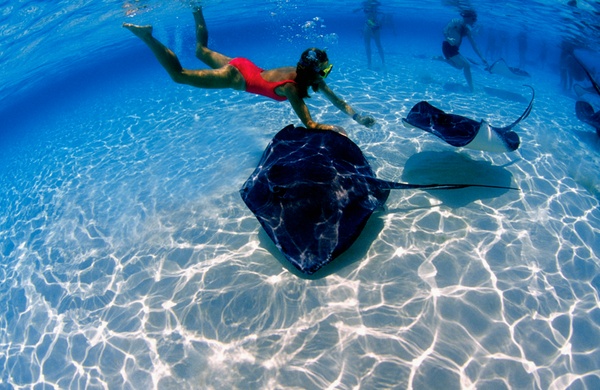The Six Best Places to Snorkel in the Caribbean

The Caribbean Sea is a cornucopia of colorful sea creatures, and you don’t need any prior experience to see them up close (although swimming skills come in handy). For the best snorkeling in the Caribbean, grab a mask, snorkel, and underwater camera and check out these six spots.
6. Stingray City | Grand Cayman, Cayman Islands

Why it’s great: You can safely feed, pet, and swim with dozens of stingrays.
When to go: To avoid crowds, go on a day when there are no cruise ships docked in George Town’s port.
What you’ll see: Atlantic Southern stingrays; most tours also visit nearby reefs.
Good for: Beginning to intermediate snorkelers. Swimming’s not required—you can see and touch the stingrays while standing in just 3 feet of water. You’ll need more experience if you visit nearby reefs, though.
Getting here: Fly into Owen Roberts International Airport (GCM) in George Town. Most tours will pick you up from your hotel free of charge.
5. Champagne Reef | Dominica

Why it’s great: Tiny bubbles created by geothermal vents make you feel as though you’re swimming in champagne.
When to go: Visit between November and May to avoid hurricane season.
What you’ll see: Seahorses, parrotfish, Caribbean spiny lobsters, and colorful sponges
Good for: Beginning snorkelers
Getting here: Fly into Melville Hall airport (DOM) via San Juan, Puerto Rico. Champagne Reef is about an hour’s drive away.
4. Trunk Bay | St. John, US Virgin Islands

Why it’s great: Marked underwater trails a few steps from the beach feature signs that identify various species of coral. Locals boast that you can see more than 50 species in 30 minutes.
When to go: Visit between November and May to avoid hurricane season.
What you’ll see: Trumpetfish and parrotfish
Good for: Beginning snorkelers. The reef is shallow and calm, and there’s usually a lifeguard on duty.
Getting here: Fly into Cyril E. King Airport (STT) in Charlotte Amalie, St. Thomas, and take a 35- to 45-minute ferry ride to Cruz Bay, St. John. Trunk Bay is about a 10-minute drive from here. Americans don’t need a passport, since it’s a US territory.
3. Isla Mujeres | Mexico

Why it’s great: Isla Mujeres is one of the best spots in the world to swim with whale sharks, who migrate around the northeastern tip of the Yucatán Peninsula each year.
When to go: Between June and August, during peak migration
What you’ll see: Whale sharks that measure 20–25 feet in length and weigh more than 10 tons (don’t worry—they feed only on plankton).
Good for: Intermediate snorkelers. Tours travel 60–90 minutes north of the island, and the waters can get choppy.
Getting here: Fly into Cancún International Airport (CUN). Isla Mujeres is a 15-minute ferry ride from Cancún.
2. Hol Chan Marine Reserve | Belize

Why it’s great: Lots of large sea creatures live among the limestone formations here along the Belize Barrier Reef.
When to go: Visit between November and May to avoid hurricane season.
What you’ll see: Shimmering schools of grunts, nurse sharks, and Atlantic Southern stingrays
Good for: Beginning to advanced snorkelers. The reserve’s four zones range from calm mangroves and seagrass beds to a channel in the reef, which can have very strong currents.
Getting here: Fly into Philip S. W. Goldson International Airport (BZE) in Belize City and take a 90-minute ferry ride to San Pedro on Ambergris Caye. The marine reserve is a 20-minute boat ride from Ambergris Caye’s shore.
1. No Name Beach | Klein Bonaire, Bonaire

Why it’s great: A national marine park protects Bonaire’s underwater inhabitants. Some of the best snorkeling is at Klein Bonaire, a half mile from the main island.
When to go: Visit during high tide, when you’re less likely to damage the shallow reefs.
What you’ll see: Fire and orange cup corals, angelfish, tube sponges, and sea turtles
Good for: Beginning to intermediate snorkelers. The reefs vary from 3 to more than 10 feet in depth, and a light current could carry you 20–30 feet.
Getting here: Fly into Flamingo International Airport (BON) in Kralendijk and take a water taxi, snorkeling tour, motorboat, or kayak to Klein Bonaire.
Photos: The Champagne beach by Antoine Hubert under CC BY-ND 2.0, Trunk Bay on St. John by Fred Hsu under CC BY-SA 3.0, and giant anemone Condylactis gigantea by Paul Asman and Jill Lenoble under CC BY 2.0

